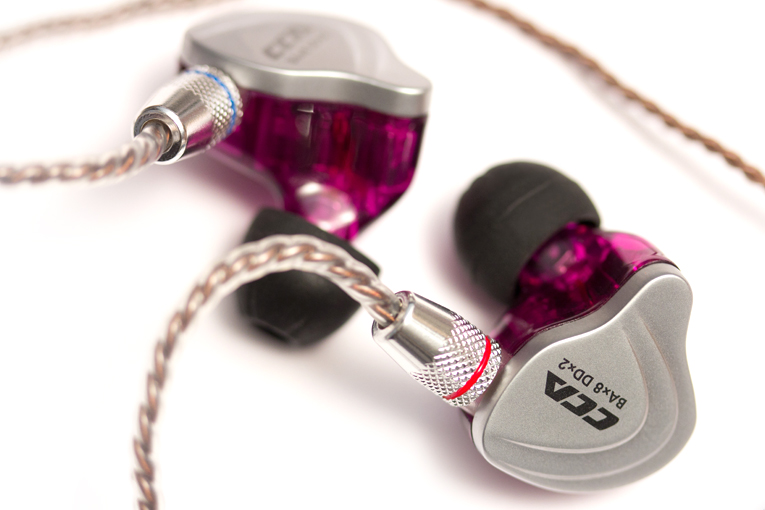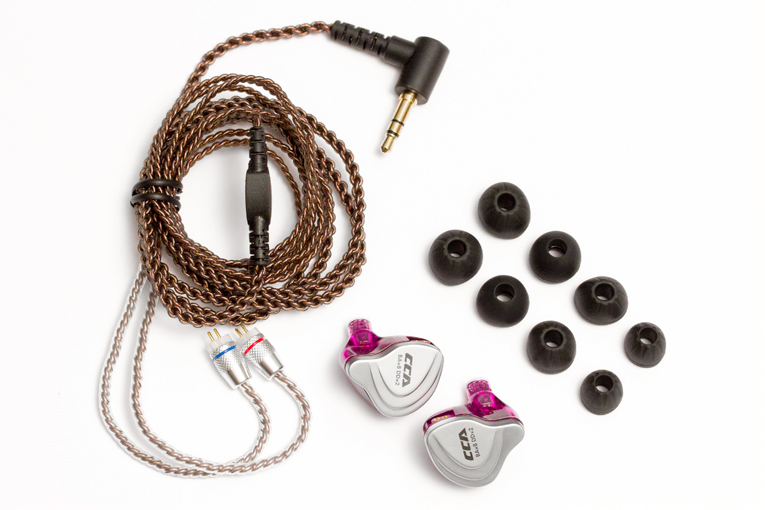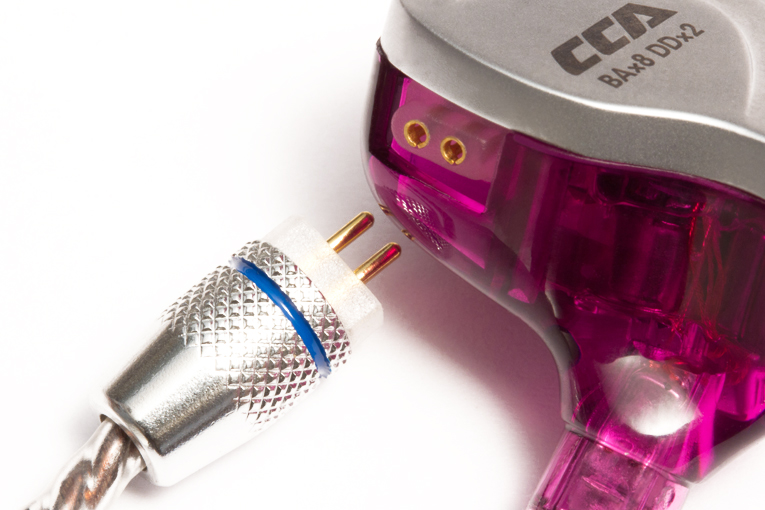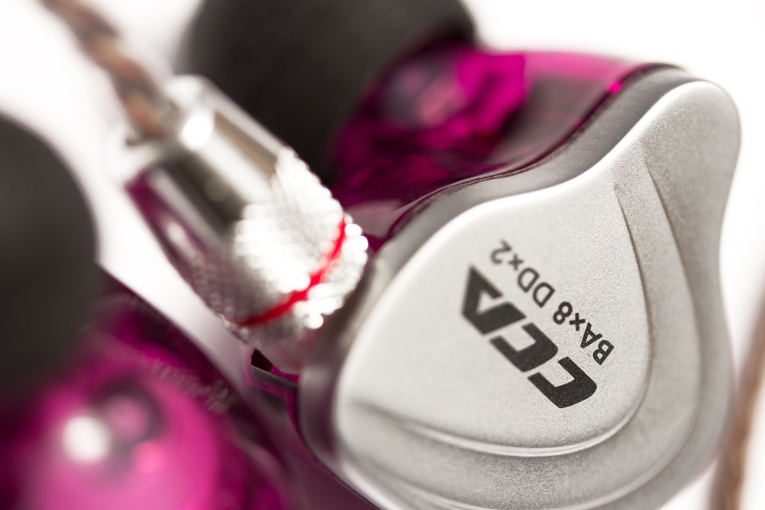Sound: 









Value: 









(Read about our ratings)
Measurements can be found by clicking this link.
Because I test only 36 headphones and earphones a year for SoundStage! Solo, our review slots are usually filled with old-school brands like AKG and Sennheiser, along with the companies that regularly show up at US headphone shows, such as HiFiMan and Dan Clark Audio. That means many lesser-known brands usually don’t attract my attention. But if you’re reading this site and you’re on Facebook, then Facebook has surely tagged you as a headphone enthusiast, and routinely serves you ads for earphones with unfamiliar brands at too-low-to-believe prices.
Recently, I saw a Facebook ad for the CCA C10s: earphones priced at just $40.99 (all prices in USD) and packed with four balanced armatures (two for treble, two for mids) and one dynamic bass driver, a combination I’d expect to see priced ten to 20 times higher. “What the hell, 40 bucks,” I thought, and ordered them. Paid for with the Citibank Visa rewards piped monthly into my Amazon account, the C10s were essentially free (or so various corporate behemoths would like me to think).

CCA is an offshoot brand of KZ Acoustics, a large Chinese manufacturer I became aware of after photographer Lee Shelly hipped me to the KZ ZST Pros, a $19.99 set of hybrid earphones that turned out to be quite good. Most of the company’s models seem targeted at enthusiasts, because most use complex driver configurations with over-the-ear cable routing, which allows for a more secure fit and, often, a better acoustical seal. You can also buy CCA earphones with fewer drivers for a little less money, or more drivers for a little more money.
There’s also a version of the C10 with an inline microphone for a couple of bucks more, and a Pro model of the C10 for about $10 more. The Pro model has a thicker aluminum outer shell and an aluminum sound tube, and because it carries a lower rated impedance (24 ohms, versus 32 for the standard C10), I assume there’s something different going on inside, even though the driver configuration appears to be the same.
With their 32-ohm rated impedance and 108dB rated sensitivity, the C10s should be easy for any source device to drive. But to be sure, check out my measurements, available from the link at the top of this review.
In the box
CCA doesn’t supply much with the C10s, so plan on adding some accessories to that Amazon order. Mine came with silicone tips in four sizes—but a glance at the photo below will tell you that they are really three slight variants of a large size, plus one small size. The cable is 4.5′ (1.4m) long, tipped with a 3.5mm (1/8″) plug on the source end and dual-pin connectors on the other ends—a common cable configuration, making the C10s compatible with many aftermarket cables and true wireless adapters. A case is not included, but they’re available for a few bucks on Amazon.

Use
As is often the case with earphones, none of the supplied tips fit my extra-large ear canals, so I substituted SpinFit CP100 XL tips. I got a comfortable, secure fit that kept the C10s in my ears during my dog walks and holiday gift-wrapping sessions.
The C10s were easy to drive straight out of the headphone jack of my Samsung Galaxy S10 phone. I used an EarMen Eagle DAC-amplifier for my focused listening, but I didn’t need to. The Eagle has a whopping 31dB more output into 32 ohms, but the C10s don’t need the extra power, and I measured the Eagle’s output impedance at 1kHz at 3.1 ohms—slightly higher than the Samsung S10’s 2.3 ohms—so neither source has a large enough output impedance to react significantly with the inevitable impedance swings of the balanced armatures. Again, check the measurements I performed to get the full story.
Sound
After putting the C10s through a ten-hour break-in, I began using them often because they sounded pretty good and fit me well. It’s a little annoying that a brand known only to enthusiasts, and selling for less than $50, can get these basics right while decades-old, revered brands still screw it up so often, at prices an order of magnitude higher.

The beautiful version of “What’s New” from Frank Sinatra Sings for Only the Lonely (24-bit/48kHz FLAC, Reprise/Qobuz) was still queued up in Qobuz from my recent review of the Campfire Audio Holocene earphones, so I started my focused eval of the C10s there. Right off, I got the impression that the C10s offer impressive detail—in the lushly orchestrated, beautifully played instrumental break, it was easy to imagine being in Capitol Studio A in Los Angeles, with the strings and horns all in the same room with the trombone and oboe soloists. (It’s a frequent venue for press events, so I’ve been there many times and have a rough idea of what the ambience there sounds like.)
Even though the studio was packed with what amounts to a mini-orchestra, it was easy to pick out the details and sonic images of all the competing instruments. But that’s not because of some super-duper driver technology or magical tuning by some purported master of musicality—it’s merely because the lower treble was somewhat boosted. As a result, Sinatra’s voice sounded a tad coarse. Fortunately, there was enough bass to more or less balance out the treble boost. Verdict? I’d say definitely a presentation most audiophiles would dig, but those who like a fuller, more natural tonal balance would likely want to pull down the 3kHz slider in their EQ a notch or two.

Eager to see if the amped-up lower treble was a real problem or something likely to be localized to a few recordings, I put on something I knew would sound bad through trebly earphones: Joni Mitchell’s “This Flight Tonight” (Blue, 24/192 FLAC, Rhino-Warner / Qobuz), which sets her soprano against two acoustic guitars. I could definitely hear the treble boost, and overall, the presentation was tilted up perhaps 2dB brighter than I’d have preferred—but I didn’t hear this as a specific, unnatural coloration because I still got a sense of the lower resonances of the voice and guitars. “Carey,” from the same album, didn’t fare quite as well because it employs a dulcimer and a guitar, and dulcimers sound a lot thinner, so the brightness got to be a bit more of an issue for me. Again, it was the kind of presentation I think a lot of audiophiles would prefer, but I also know lots of audiophiles who like a warmer balance and who can’t stand bright-sounding headphones or earphones.
Moving to a recording I’m confident shouldn’t sound bright under any circumstances—“On Green Dolphin Street,” from jazz bassist Christian McBride’s Qobuz-exclusive The Q Sessions (24/192 FLAC, Mack Avenue / Qobuz)—I noticed the brightness much less because there wasn’t much for the brightness to grab hold of. Mike Stern’s guitar has a rolled-off, chorusy tone; Marcus Strickland has one of the fullest, least “snake-charmer flutish” sounds of any soprano sax player I can think of; and Eric Harland always wrests a mellow, warm sound from his snare and cymbals. I heard that little extra bit of brightness, but on this recording I thought it was welcome.
What was a little less welcome to my ears was the sound of McBride’s double bass. McBride usually has a rather dark, full, old-school sound that’s less trebly than most of his contemporaries prefer. The C10s kind of doubled-down on that, pumping up the upper bass to the point where McBride’s playing sounded muddy.

This made me wonder what the C10s would sound like on a straightforward rock recording, so I put on Aerosmith’s “Sweet Emotion” (Toys in the Attic, 24/96 FLAC, Columbia/Qobuz). It definitely rocked—not exactly a high bar with a tune, a performance, and a mix as solid as this—and the tonal balance was just about right. The treble boost I mentioned before was apparent only on the snare drum and cymbals, and it sounded subtle and not at all troublesome. The vocals also sounded about right. What I didn’t like was, again, the upper-bass bloat I heard. Tom Hamilton’s bass guitar sounded great in the song’s intro, where he’s accompanied only by vibraslap, voice-box guitar effects, and maracas—but once the full band came in, the bass sounded a little bloated. Not bad, but a little less upper bass would have resulted in a tighter-sounding groove. To be fair, though, that upper-bass bloat is a common thing to hear in headphones and earphones.
Comparison
I didn’t happen to have many inexpensive earphones around because I rarely review them, but I did have some earphones with a similar driver count: the 1More Quad Drivers (originally $199.99, now $149.99), which use three balanced armatures and one dynamic driver.
This comparison gave me a different perspective on the C10s. The Quad Drivers were hailed as one of the best $200 earphones on the market when they emerged about four-and-a-half years ago, and I will say that they sounded flatter (from a frequency-response standpoint) and in ways more natural than the C10s—but the C10s just sounded so much more lively on cuts like Steely Dan’s “Cousin Dupree” (Two Against Nature, 24/96 FLAC, Giant-Reprise / Qobuz). The extra brightness and the upper-bass boost were still apparent, but the upper mids and the whole treble range sounded much clearer through the C10s. In comparison, the Quad Drivers sounded dull.

It’s not fair to compare $649 earphones like the Campfire Holocenes to earphones costing one-thirteenth as much, but I had the Holocenes on hand, so I gave it a try. I’d praised the Holocenes for smooth, detailed mids and highs, but dinged them a bit for being light in the bass. Playing Holly Cole’s super-familiar (to audiophiles) recording of “Train Song” (Temptation, 16/44.1 FLAC, Blue Note / Qobuz), I actually preferred the C10s’ bass to the Holocenes’ bass because the little bit of upper-bass bloat I heard with the C10s also gave them a fuller, more natural tonal balance. That said, the C10s’ mids and treble sounded somewhat crude compared with the Holocenes; I heard the same coarseness in Holly Cole’s voice that I heard in Sinatra’s, and neither of these singers sounds like that. The C10s also couldn’t match the Holocenes’ natural, layered sense of space.
Conclusion
As someone who usually reviews earphones priced between $200 and $1500, I found that putting a $41 set of earphones in perspective is tough. There’s no question at all that the C10s are a high-quality set of earphones. I do have a qualm or two about their voicing, but from an ergonomics standpoint, I’d rank them a nine on a scale of ten—something that’s not the case with at least half the high-end earphones I’ve tested. And I’d say most of the C10s’ flaws could be corrected with a subtle touch of EQ.
One thing’s for sure: I need to review more under-$100 multi-driver earphones!
. . . Brent Butterworth
Associated Equipment
- Smartphone: Samsung Galaxy S10.
- DAC-headphone amplifier: EarMen Eagle.
CCA C10 Earphones
Price: $40.99.
Warranty: One year.
KZ Acoustics
Website: www.kzhifi.com





